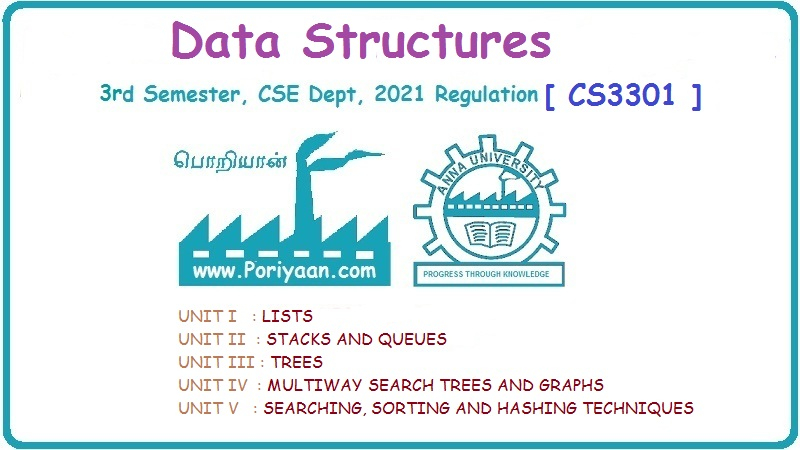Data Structure: Unit III: Trees
Representation of Tree
ADT Data Structure
There are two ways of representing the binary tree. 1. Sequential representation, 2. Linked representation.
Representation
of Tree
There
are two ways of representing the binary tree.
1. Sequential representation
2. Linked representation.
Let us
see these representations one by one.
1. Sequential representation of binary trees or
array representation :
Each
node is sequentially arranged from top to bottom and from left to right. Let us
understand this matter by numbering each node. The numbering will start from
root node and then remaining nodes will give ever increasing numbers in level
wise direction. The nodes on the same level will be numbered from left to
right. The numbering will be as shown below.
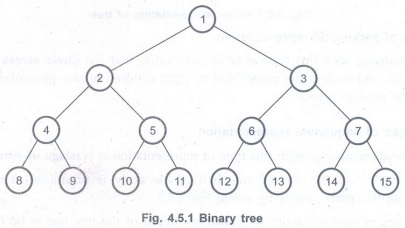
Now,
observe Fig. 4.5.1 carefully. You will get a point that a binary tree of depth
n having 2n-1 number of nodes. In Fig. 4.5.1 the tree is having the
depth 4 and total number of nodes are 15. Thus remember that in a binary tree
of depth n there will be maximum 2n-1 nodes. And so if we know the
maximum depth of the tree then we can represent binary tree using arrays data
structure. Because we can then predict the maximum size of an array that can
accommodate the tree.
Thus
array size can be >=n. The root will be at index 0. Its left child will be
at index 1, its right child will be at index 2 and so on. Another way of
placing the elements in the array is by applying the formula as shown below-
• When n
= 0 the root node will placed at 0th location
•Parent(n)
= floor(n-1)/2
•Left(n)
= (2n+1)
• Right(n)
= (2n+2).

Advantages of sequential representation
The only
advantage with this type of representation is that the direct access to any
node can be possible and finding the parent, left or right children of any
particular node is fast because of the random access.
Disadvantages of sequential representation
1.The
major disadvantage with this type of representation is wastage of memory.
For
example: In the skewed tree half of the array is unutilized. You can easily
understand this point simply by seeing Fig. 4.5.3.
2. In
this type of representation the maximum depth of the tree has to be fixed
because we have already decided the array size. If we choose the array size
quite larger than the depth of the tree, then it will be wastage of the memory.
And if we choose array size lesser than the depth of the tree then we will be
unable to represent some part of the tree. The insertions and deletion of any
node in the tree will be costlier as other nodes have to be adjusted at
appropriate positions so that the meaning of binary tree can be preserved.
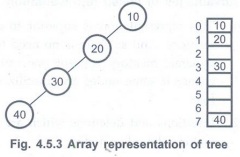
As these
drawbacks are there with this sequential type of representation, we will search
for more flexible representation. So instead of array we will make use of
linked list to represent the tree.
2. Linked representation or node representation
of binary trees
In
binary tree each node will have left child, right child and data field.

The left
child is nothing but the left link which points to some address of left subtree
whereas right child is also a right link which points to some address of right
subtree. And the data field gives the information about the node. Let us see
the 'C' structure of the node in a binary tree.
typedef
struct node
{
int
data;
struct
node *left;
struct
node *right;
}bin;
The tree
with Linked representation is as shown below -

Advantages of linked representation
1. This
representation is superior to our array representation as there is no wastage
of memory. And so there is no need to have prior knowledge of depth of the
tree. Using dynamic memory concept one can create as many memory (nodes) as
required. By chance if some nodes are unutilized one can delete the nodes by
making the address free.
2.
Insertions and deletions which are the most common operations can be done
without moving the other nodes.
Disadvantages of linked representation
1.This
representation does not provide direct access to a node and special algorithms
are required.
2.This
representation needs additional space in each node for storing the left and
right sub-trees.
Ex. 4.5.1: For the given data draw a binary
tree and show the array representation of the same: 100 80 45 55 110 20 70 65
Sol. The binary tree will be
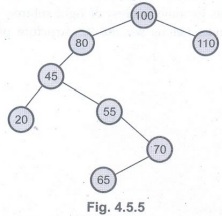

Formula
used for placing the node values in array are
1. Root
will be at 0th location
2.
Parent(n) - floor (n - 1)/2
3. Left
(n) = (2n+1)
4. Right
(n) = (2n + 2)
where n
> 0.
Ex. 4.5.2: What is binary tree? Show the array
representation and linked representation for the following binary tree.
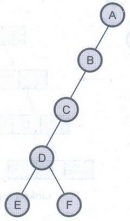
Sol. Binary Tree: Binary
Tree is a finite set of nodes which is either empty or consists of a root and
two disjoint binary trees called left subtree and right subtree.
Array Representation

Root = A
= index 0
Left(0) =
2*0 + 1 = 1
B =
Index 1
Left (1)
= 2*1+1=3
C =
Index 3
Left (3)
= 2*3+1 = 7
D =
Index 7
Left (7)
= 2*7+1=15
E =
Index 15
Right
(7) = 2*7 +2 = 16
F =
Index 16
Linked Representation

Data Structure: Unit III: Trees : Tag: : ADT Data Structure - Representation of Tree
Related Topics
Related Subjects
Data Structure
CS3301 3rd Semester CSE Dept | 2021 Regulation | 3rd Semester CSE Dept 2021 Regulation
